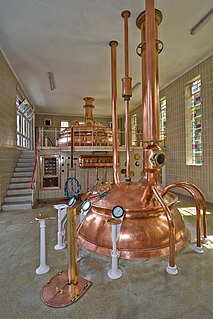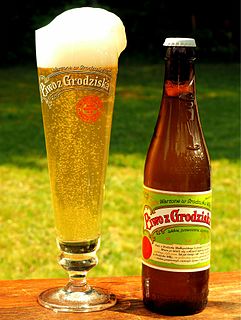
Beer is one of the oldest and most widely consumed alcoholic drinks in the world, and the third most popular drink overall after water and tea. Beer is brewed from cereal grains—most commonly from malted barley, though wheat, maize (corn), and rice are also used. During the brewing process, fermentation of the starch sugars in the wort produces ethanol and carbonation in the resulting beer. Most modern beer is brewed with hops, which add bitterness and other flavours and act as a natural preservative and stabilizing agent. Other flavouring agents such as gruit, herbs, or fruits may be included or used instead of hops. In commercial brewing, the natural carbonation effect is often removed during processing and replaced with forced carbonation.

Brewing is the production of beer by steeping a starch source in water and fermenting the resulting sweet liquid with yeast. It may be done in a brewery by a commercial brewer, at home by a homebrewer, or by a variety of traditional methods such as communally by the indigenous peoples in Brazil when making cauim. Brewing has taken place since around the 6th millennium BC, and archaeological evidence suggests that emerging civilizations, including ancient Egypt and Mesopotamia, brewed beer. Since the nineteenth century the brewing industry has been part of most western economies.

Draught beer, also spelt draft, is beer served from a cask or keg rather than from a bottle or can. Draught beer served from a pressurised keg is also known as keg beer.

Real ale is the name coined by the Campaign for Real Ale (CAMRA) for "beer brewed from traditional ingredients, matured by secondary fermentation in the container from which it is dispensed, and served without the use of extraneous carbon dioxide".

George Gale & Co. Ltd was a Hampshire brewery with a distinctive range of, mainly, bitter beers. Founded in 1847 it was bought by the London brewers, Fullers of Chiswick in 2005. The brewery was closed in 2006 with production transferred to Chiswick.

Homebrewing is the brewing of beer, mead, and ciders on a small scale for personal, non-commercial purposes. Supplies, such as kits and fermentation tanks, can be purchased locally at specialty stores or online. Alcohol has been brewed on the domestic level since its advent, thousands of years prior to its commercial production, although its legality has varied according to local regulation. In the United States, a permit is required to distill spirits such as moonshine.

Isinglass is a substance obtained from the dried swim bladders of fish. It is a form of collagen used mainly for the clarification or fining of some beer and wine. It can also be cooked into a paste for specialised gluing purposes.

A keg is a small barrel.

Wadworth is a brewery company founded in 1875 in Devizes, Wiltshire, England, best known for their 6X beer brand.

Beer in England has been brewed for hundreds of years. As a beer brewing country, England is known for its top fermented cask beer which finishes maturing in the cellar of the pub rather than at the brewery and is served with only natural carbonation.

Timothy Taylor's is a family-owned regional brewery founded in 1858 by Timothy Taylor. Originally based in Cook Lane, Keighley, West Yorkshire, England. Timothy Taylor's moved to larger premises in 1863 at Knowle Spring in Keighley, where they remain.

Lees are deposits of dead yeast or residual yeast and other particles that precipitate, or are carried by the action of "fining", to the bottom of a vat of wine after fermentation and aging. The same while brewing beer at a brewery is known as trub – the same from secondary fermentation of wine and beer are the lees or equally, as to beer only, dregs. This material is the source for most commercial tartaric acid, which is used in cooking and in organic chemistry.

The Worthington Brewery, also known as Worthington & Co. and Worthington's, was founded by William Worthington in the English Midlands town of Burton upon Trent in 1761. It is the second oldest continuously brewed British beer brand after Whitbread. The best known Worthington beers are the Creamflow nitrokeg bitter and White Shield India Pale Ale.

A beer engine is a device for pumping beer from a cask, usually located in a pub's cellar.

Guinness is a dark Irish dry stout that originated in the brewery of Arthur Guinness at St. James's Gate, Dublin, Ireland, in 1759. It is one of the most successful alcohol brands worldwide, brewed in almost 50 countries, and available in over 120. Sales in 2011 amounted to 850 million litres (220,000,000 US gal). It is popular with the Irish, both in Ireland and abroad. In spite of declining consumption since 2001, it is still the best-selling alcoholic drink in Ireland where Guinness & Co. Brewery makes almost €2 billion worth of beer annually.

A brewery or brewing company is a business that makes and sells beer. The place at which beer is commercially made is either called a brewery or a beerhouse, where distinct sets of brewing equipment are called plant. The commercial brewing of beer has taken place since at least 2500 BC; in ancient Mesopotamia, brewers derived social sanction and divine protection from the goddess Ninkasi. Brewing was initially a cottage industry, with production taking place at home; by the ninth century monasteries and farms would produce beer on a larger scale, selling the excess; and by the eleventh and twelfth centuries larger, dedicated breweries with eight to ten workers were being built.

Beer is often made from barley malt, water, hops and yeast and so is often suitable for vegans and vegetarians. Some beer brewers add finings to clarify the beer when racking into a barrel. Finings can include plant-derived products, like Irish moss, or animal-derived products, like isinglass and gelatin.

Filtered beer refers to any ale, lager, or fermented malt beverage in which the sediment left over from the brewing process has been removed. Ancient techniques included the use of straw mats, cloth, or straws, and frequently left some sediment in the drink. Modern filtration, introduced at the end of the 19th century, uses a mechanical process that can remove all sediment, including yeast, from the beer. Such beer is known as bright beer and requires force carbonation before bottling or serving from a keg. In the United Kingdom, a beer which has been filtered in the brewery is known as "brewery-conditioned", as opposed to unfiltered cask ales.
The methods used to produce beer may be unique to a beer style, geographic region, or company. In 19th century Britain, technological discoveries and improvements such as Burtonisation and the Burton Union system significantly changed beer brewing.

Grodziskie is a historical style of beer from Poland that is typically made from oak-smoked wheat malt. The beer can be described as having a clear, light golden color, high carbonation, low alcohol content, low to moderate levels of hop bitterness, and a strong smoke flavor and aroma. The taste is light and crisp, with primary flavors coming from the smoked malt, the high mineral content of the water, and the strain of yeast used to ferment the beverage. The beer was nicknamed "Polish Champagne" because of its high carbonation levels, and because it was valued as a high-quality beverage to be used for special occasions.



















